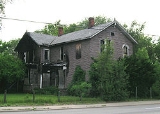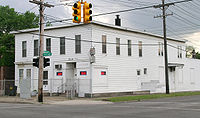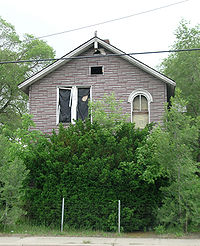
Philetus W. Norris House
Encyclopedia
The Philetus W. Norris House is located at 17815 Mt. Elliott Avenue in Detroit, Michigan
, near the corner of Mound Road and Davison Avenue. It was built in 1873 by Philetus W. Norris, who went on to become the second superintendent of Yellowstone National Park
. The house was listed on the National Register of Historic Places
in 1992.
, New York
in 1821, the son of John Norris, Jr. and Azubah Phelps. In 1826, they bought 80 acres (323,748.8 m²) in Michigan, moving there soon thereafter.
Norris left school early and traveled all around the midwest to trap and trade. He In 1838, Norris settled in northwest Ohio
, and in 1845 he married Jane K. Cottrell. They had four children: Edward, Aurelia, Ida and Arthur. Norris fought in the Civil War
began, served as a spy, and eventually rose to the rank of Colonel.
After the Civil War, Norris moved to Michigan, where he founded the town of Norris in 1873 and ran a successful real estate and newspaper business. In 1877, Norris became the second superintendent of Yellowstone National Park, a position he held until 1882. Norris died in 1885, and is buried in Woodmere Cemetery.
 When Norris moved to Michigan, he managed land which belonged to officers and soldiers of both the Union and Confederate armies as part of a federal contract. In 1873, he platted the village of Norris in Wayne County
When Norris moved to Michigan, he managed land which belonged to officers and soldiers of both the Union and Confederate armies as part of a federal contract. In 1873, he platted the village of Norris in Wayne County
at the location where his house now still stands. Norris had originally wanted to name the town "Prairie Mound," but the Detroit and Bay City Railroad (who Norris had convinced to run through the area) posted "Norris" on the depot, and the name stuck.
The original village boundaries were roughly Seven Mile Road on the north, Mound Road on the west, Six Mile Road on the south, and Van Dyke Road on the east. To ensure the success of his community, Norris drained the creek that ran through the area to open up land for farming and maintained the plank road that ran between Detroit and Mount Clemens
, operating a tollbooth located in the village. Norris also built the Two Way Inn, which was originally the village's jail and general store; Norris lived there until he built his nearby house. The Two Way Inn still stands as of 2008; other than a nearby church and the Philetus W. Norris House itself, it is the only building remaining from the original village of Norris.
The village was settled primarily by German Lutherans, farmers who sold their produce to Detroit residents. By 1880, the population of Norris had grown to approximately 250 people . The village boasted, in addition to the railroad depot, a hotel, wagon shop, sawmill, multiple homes, and more. In 1891, the village of Norris was renamed "North Detroit." The city boundaries of Detroit gradually crept nearer, and in 1924 Detroit annexed the village. The only modern-day indication that the area was once a separate village is the "Nortown" moniker on some local businesses, evoking the old names of "Norris" and "North Detroit."

 The Philetus W. Norris House was built in 1873; it is a two-story late Victorian
The Philetus W. Norris House was built in 1873; it is a two-story late Victorian
vernacular
structure. At the time it was built, the home had gingerbread trim, brick chimneys and leafy trees in its yard. Norris moved from the Two Way Inn into this house, and also constructed a wing along one side from which he ran his real estate business.
Norris moved to Yellowstone in 1877, but the Norris family owned the house until 1916, when they sold it to William Lynch. Lynch used it in part to operate a boarding house, and sold the home in 1925, when it was converted to a three-family unit. The house was owned and occupied by a series of residents, and in 1965 was converted back to a single-family residence; this may have been the time when the exterior was covered with the asphalt siding still on the house today. The home was occupied until 1991, when the last owner moved out and the property was listed as abandoned and tax delinquent.
The house was placed on the National Register of Historic Places
in 1992, and was designated a city of Detroit historic district in 1995. The Nortown Community Development Corporation purchased the house with plans to restore it, but in 1999 an arsonist badly damaged the property. As of 2008, the home is abandoned, although plans are still in the works to complete restoration.
Michigan
Michigan is a U.S. state located in the Great Lakes Region of the United States of America. The name Michigan is the French form of the Ojibwa word mishigamaa, meaning "large water" or "large lake"....
, near the corner of Mound Road and Davison Avenue. It was built in 1873 by Philetus W. Norris, who went on to become the second superintendent of Yellowstone National Park
Yellowstone National Park
Yellowstone National Park, established by the U.S. Congress and signed into law by President Ulysses S. Grant on March 1, 1872, is a national park located primarily in the U.S. state of Wyoming, although it also extends into Montana and Idaho...
. The house was listed on the National Register of Historic Places
National Register of Historic Places
The National Register of Historic Places is the United States government's official list of districts, sites, buildings, structures, and objects deemed worthy of preservation...
in 1992.
Philetus W. Norris
Philetus W. Norris was born in PalmyraPalmyra, New York
Palmyra, New York may refer to:*Palmyra , New York*Palmyra , New York...
, New York
New York
New York is a state in the Northeastern region of the United States. It is the nation's third most populous state. New York is bordered by New Jersey and Pennsylvania to the south, and by Connecticut, Massachusetts and Vermont to the east...
in 1821, the son of John Norris, Jr. and Azubah Phelps. In 1826, they bought 80 acres (323,748.8 m²) in Michigan, moving there soon thereafter.
Norris left school early and traveled all around the midwest to trap and trade. He In 1838, Norris settled in northwest Ohio
Ohio
Ohio is a Midwestern state in the United States. The 34th largest state by area in the U.S.,it is the 7th‑most populous with over 11.5 million residents, containing several major American cities and seven metropolitan areas with populations of 500,000 or more.The state's capital is Columbus...
, and in 1845 he married Jane K. Cottrell. They had four children: Edward, Aurelia, Ida and Arthur. Norris fought in the Civil War
American Civil War
The American Civil War was a civil war fought in the United States of America. In response to the election of Abraham Lincoln as President of the United States, 11 southern slave states declared their secession from the United States and formed the Confederate States of America ; the other 25...
began, served as a spy, and eventually rose to the rank of Colonel.
After the Civil War, Norris moved to Michigan, where he founded the town of Norris in 1873 and ran a successful real estate and newspaper business. In 1877, Norris became the second superintendent of Yellowstone National Park, a position he held until 1882. Norris died in 1885, and is buried in Woodmere Cemetery.
Village of Norris

Wayne County, Michigan
-History:Wayne County was one of the first counties formed when the Northwest Territory was organized. It was named for the American general "Mad Anthony" Wayne. It originally encompassed the entire area of the Lower Peninsula of Michigan, as well as small sections that are now part of northern...
at the location where his house now still stands. Norris had originally wanted to name the town "Prairie Mound," but the Detroit and Bay City Railroad (who Norris had convinced to run through the area) posted "Norris" on the depot, and the name stuck.
The original village boundaries were roughly Seven Mile Road on the north, Mound Road on the west, Six Mile Road on the south, and Van Dyke Road on the east. To ensure the success of his community, Norris drained the creek that ran through the area to open up land for farming and maintained the plank road that ran between Detroit and Mount Clemens
Mount Clemens, Michigan
Mount Clemens is a city in the U.S. state of Michigan. As of the 2000 census, the city population was 17,312. It is the county seat of Macomb County.-Early history:...
, operating a tollbooth located in the village. Norris also built the Two Way Inn, which was originally the village's jail and general store; Norris lived there until he built his nearby house. The Two Way Inn still stands as of 2008; other than a nearby church and the Philetus W. Norris House itself, it is the only building remaining from the original village of Norris.
The village was settled primarily by German Lutherans, farmers who sold their produce to Detroit residents. By 1880, the population of Norris had grown to approximately 250 people . The village boasted, in addition to the railroad depot, a hotel, wagon shop, sawmill, multiple homes, and more. In 1891, the village of Norris was renamed "North Detroit." The city boundaries of Detroit gradually crept nearer, and in 1924 Detroit annexed the village. The only modern-day indication that the area was once a separate village is the "Nortown" moniker on some local businesses, evoking the old names of "Norris" and "North Detroit."
Philetus W. Norris House


Victorian architecture
The term Victorian architecture refers collectively to several architectural styles employed predominantly during the middle and late 19th century. The period that it indicates may slightly overlap the actual reign, 20 June 1837 – 22 January 1901, of Queen Victoria. This represents the British and...
vernacular
Vernacular architecture
Vernacular architecture is a term used to categorize methods of construction which use locally available resources and traditions to address local needs and circumstances. Vernacular architecture tends to evolve over time to reflect the environmental, cultural and historical context in which it...
structure. At the time it was built, the home had gingerbread trim, brick chimneys and leafy trees in its yard. Norris moved from the Two Way Inn into this house, and also constructed a wing along one side from which he ran his real estate business.
Norris moved to Yellowstone in 1877, but the Norris family owned the house until 1916, when they sold it to William Lynch. Lynch used it in part to operate a boarding house, and sold the home in 1925, when it was converted to a three-family unit. The house was owned and occupied by a series of residents, and in 1965 was converted back to a single-family residence; this may have been the time when the exterior was covered with the asphalt siding still on the house today. The home was occupied until 1991, when the last owner moved out and the property was listed as abandoned and tax delinquent.
The house was placed on the National Register of Historic Places
National Register of Historic Places
The National Register of Historic Places is the United States government's official list of districts, sites, buildings, structures, and objects deemed worthy of preservation...
in 1992, and was designated a city of Detroit historic district in 1995. The Nortown Community Development Corporation purchased the house with plans to restore it, but in 1999 an arsonist badly damaged the property. As of 2008, the home is abandoned, although plans are still in the works to complete restoration.

